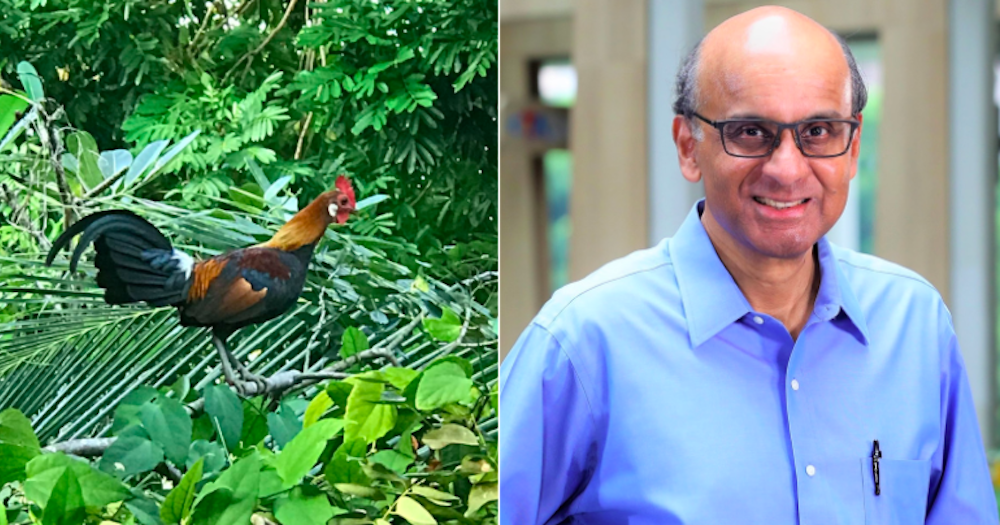The relocation of free-ranging chickens at Sin Ming had ruffled some feathers among residents of the estate earlier this month.
These Sin Ming chickens include the Red junglefowl (Gallus gallus) which is a threatened species of chickens in Singapore.
The Red junglefowl is however not exclusive to Sin Ming estates.
Senior Minister Tharman Shanmugaratnam shared a photo of one possible Red junglefowl spotted at Turf City recently.
In the Facebook post shared last Sunday (Oct. 25), Tharman explained how one can identify the Red junglefowl.
He also shared some educational fun facts about this native species, which is also the ancestor of all domestic chickens.
Many free-ranging chickens are mixed breeds
In his post, Tharman highlighted that our local free-ranging chicken can be "stunningly attractive", and that "many are mixed breeds".
He then cited a genetic study conducted by the National University of Singapore (NUS) and the National Parks Board (NParks) which found that most free-ranging chickens in Singapore are hybrids of domestic chickens and the Red junglefowl.
While the same study recommended removing mixed breeds that do not meet the minimum standard of being considered a "wild" individual, according to genetic and physical features, it also highlighted the difficulty in identifying these individuals.
Some scientists argue if there even is a "pure" wild population of red junglefowl, citing thousands of years of potential contact with domestic chickens.
There are however physical features that one can tell which chickens are more "Red junglefowl-like" than others.
How to spot Red junglefowl?
Tharman shared that the chicken in his post exhibited features of a male Red junglefowl, which are:
- Grey legs
- White patch on its face (or lappet)
- White patch at its bottom (or rump)
- Arched glossy, dark green tail feathers
- Colourful body feathers
- Smaller in body mass (as compared to domesticated chickens)
He added that female hens of the species have shorter, fan-shaped tails.
Adding on to those physical characteristics, the Red junglefowl is capable of flying short distances and roosting in trees at night to avoid predators, unlike domestic chickens.
Tharman then ended his post by highlighting that the Red junglefowl should survive in forests and remain part of our local biodiversity.
"They should survive in our forests and densely vegetated areas, and remain part of the island’s biodiversity."
Bring back memories from good old days
In response to Tharman's post, many Singaporeans commented that they notice free-ranging chickens in their neighbourhoods too.
The free-ranging chickens remind them of the "good old days", "childhood days" and retain some "kampong atmosphere" in urban areas.
Recently, one Sin Ming resident, Jun Chong, who is also a filmmaker, shared how these free-ranging chickens have become part of the town's identity.
In a video made in response to the recent move to relocate a few Sin Ming chickens to Seletar, he said:
"If one day there is no Sin Min chickens in Sin Ming, I feel that it's no longer Sin Ming. The estate is made up so much...Not only in its people, but also the environment as well."
You can watch the full video here:
Totally unrelated but follow and listen to our podcast here
Top image from Tharman Shanmugaratnam/FB
If you like what you read, follow us on Facebook, Instagram, Twitter and Telegram to get the latest updates.
